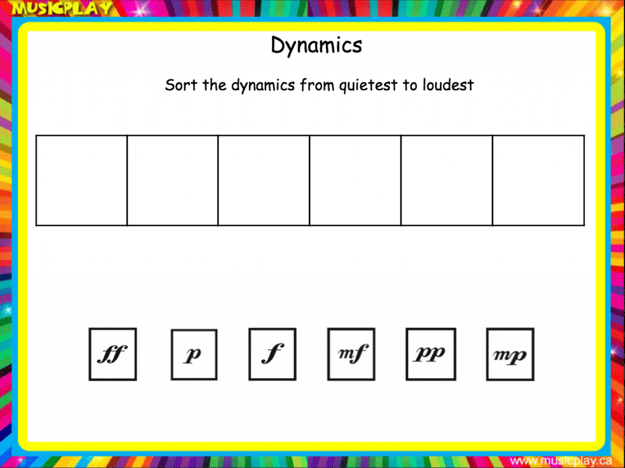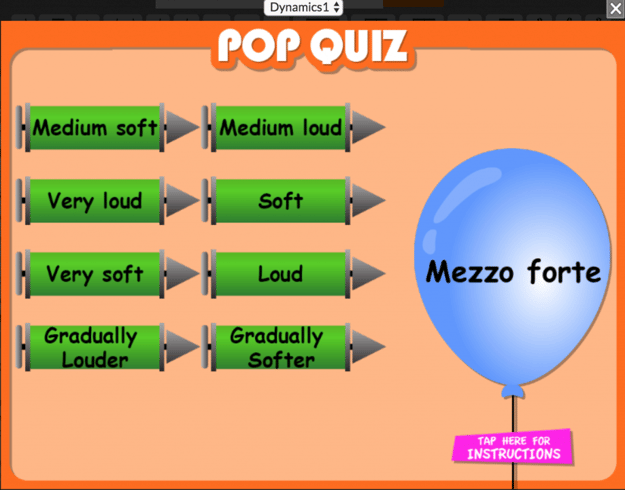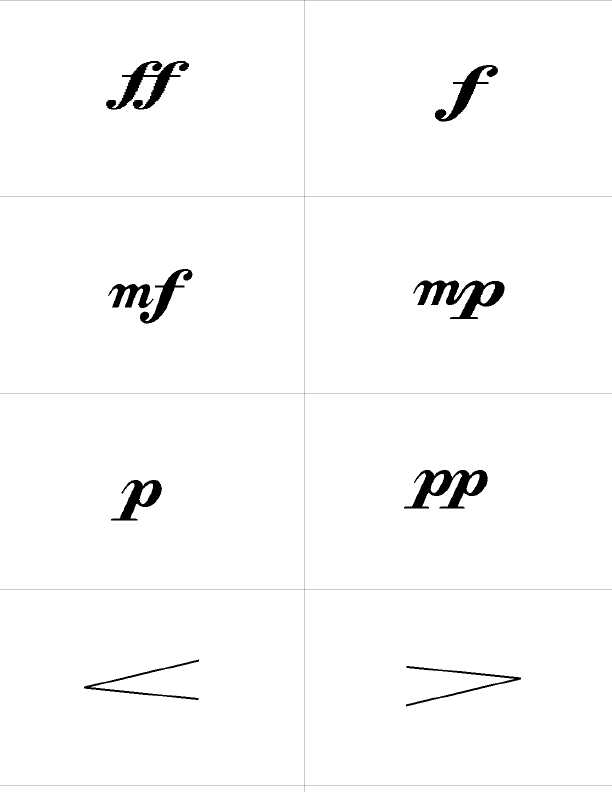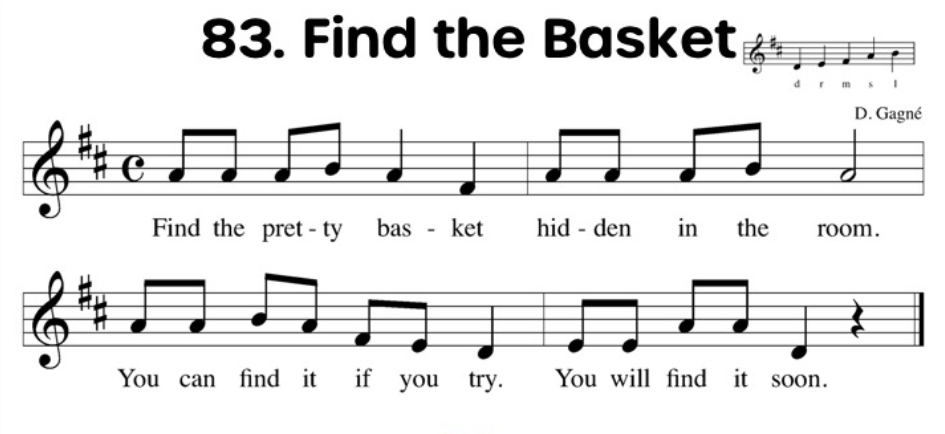Dynamics Lesson Plan for Spring
Dynamics Lesson Plan for K-5 Music Classes
Lesson is from the Musicplay 2 curriculum. For info visit www.musicplay.ca
Materials:
1. Find the Easter Basket Song #75 Musicplay 2
2. Dynamics printables, Pop Quiz, Sort the Dynamics activities at musicplayonline.com
Objectives:
1. The students will identify when the music is quiet and when the music is loud
2. The students will define crescendo and decrescendo
Songs can be taught in one of three ways: rote, reading, or immersion. Choose the best method for teaching your students and teach the song and play the game.
ROTE: When teaching by rote, you teach the song phrase by phrase. You sing a phrase – the children echo. You sing the next phrase, the children echo. Then you combine phrases: you sing two phrases – the children echo. Finally, you sing the entire song, the children echo.
IMMERSION: When teaching very young children, teaching by immersion is effective. You have the children listen while you sing the song several times. They might listen and pat the beat, listen and move like you do, listen to answer a question you’ve asked. You might choose to teach Sleepy Bunnies by immersion with your youngest students.
READING: When children are able to read rhythms and/or solfege, you can begin having them sight-read a song. What a great skill for them to have! Many adults can’t look at a piece of music and sing how it goes, but if taught carefully, our children can do this.
Have the children read the rhythms using whatever rhythm names you use.
Sometimes after reading the rhythms I divide the class into two groups and have one group read the rhythms while the other groups reads the words of the song. This helps some children “connect” that rhythm in music is the way the words go.
In Musicplay, reading songs are indicated by a small staff on the upper right hand corner of the song. In the song “Find the Easter Basket” the pitches indicated are s, m, l that stand for so (or sol), mi and la. If children have learned these solfa notes, do some solfa warmups that use so, mi and la. On musicplayonline.com, you can use the Solfa Practice Section and have kids echo patterns, play poison melody, Read and Sing, or Listen and Sing so-mi-la patterns. If you don’t use musicplayonline.com you can purchase melody flashcards and do the same kind of solfa warmups with flashcards. LINK to Flashcards on USA SITE Melody Flashcards Canadian Site
Give the students a starting pitch for the song and have them sing the song
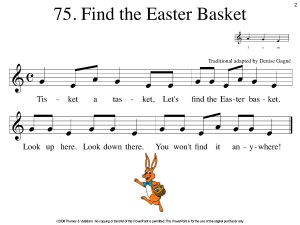
Whether you use reading or rote to teach your students a song depends on If you’ve labelled the rhythms and solfa with your students. If you haven’t taught so-mi-la yet, you’ll introduce the song as a rote song. If you have labelled so-mi-la, then you can have the students sight-sing the song.
Teach the song and play the game.
Game Directions: One student is the “hider” and one is the “finder.” The “finder” closes eyes while the “hider hides the Easter Basket in plain sight. (not under or in something). The “finder” opens eyes and is guided to the basket by the dynamics in the singing. If children sing quietly he is far away. If the children sing loudly, he’s closer.
2. After playing the song, discuss the dynamics that were used in the song. There is an excellent interactive activity at www.musicplayonline.com attached to song #11. John Jacob Jingleheimer Schmidt in Musicplay Grade 2. Sort the rhythms from quietest to loudest.
You can also play the Pop Quiz activities on Dynamics at www.musicplayonline.com to teach or practice dynamics terms.
3. Talk about what it’s called when the singing starts quietly but gets louder. (crescendo) or when the music starts loud and gets quieter. (decrescendo)
There are dynamic symbols printables with song #11. John Jacob Jingleheimer Schmidt in the teacher’s guide and musicplayonline.com that you can print out and package for your students to use. I package these in paper CD holders. It’s quick and easy to make a class set of them, and then I can use them for assessments of dynamic awareness with Gr. 2-6.
Give out a set of cards to each child.
Have them sort them from quietest to loudest. Check answers.
Quiz them on the dynamics shown.
For Example:
hold up the card that means quiet
hold up the card that means very loud
hold up the card that is the symbol for mezzo forte
Have the students be leaders, and come up with questions for the class.
Follow this activity with a listening activity that has students listen and point to the dynamic card they hear in the music. In the Listening Resource Kit 1, #29 Contradance is a great example to use to have children respond to dynamics. The Listening Resource Kits are now online at www.musicplayonline.com. The Listening Section is found on the left side menu. 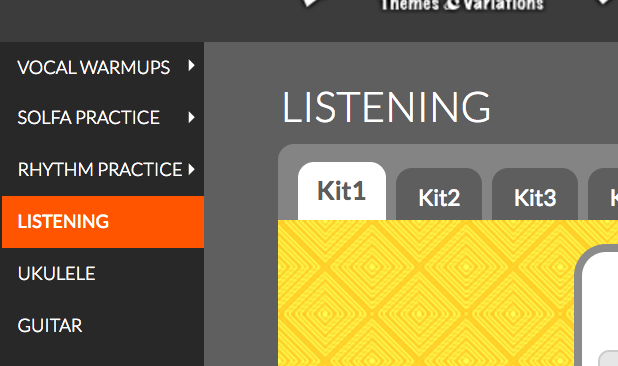
Select Kit 1, then scroll down to #29. Select the Listening Map. (Many choices are available so you can use the same example in several lessons) Hand out the dynamics cards, and play the recording. The students point to the dynamic Level (card) that they hear. Other good examples to use would include Listen 2 – #26 Summer, Vivaldi or #24 – Hornpipe. Listen 3 – #5 Entry March of the Boyars or $10 Bouree is very good or #17 Intrada, Listen 5 – March of the Dwarfs.
Hand out the dynamics cards, and play the recording. The students point to the dynamic Level (card) that they hear. Other good examples to use would include Listen 2 – #26 Summer, Vivaldi or #24 – Hornpipe. Listen 3 – #5 Entry March of the Boyars or $10 Bouree is very good or #17 Intrada, Listen 5 – March of the Dwarfs.
This lesson is from Musicplay 2. Musicplay is a standards based K-6 music curriculum with songs and activities that students LOVE! Musicplay is an award winning music program for K-6 schools. Each grade level includes 40 weekly lessons that clearly outline concepts and skills taught in each grade. Musicplay includes seasonal songs, fun songs, rounds, partner songs, folk music, multicultural music and choral music. In the Musicplay curriculum students sing, play instruments, move to music, listen, create and learn to read and write music. Important concepts are taught through play. Each week in Grades 1-5 a new singing game is taught. Children love music games making this a text that will have your students really excited about learning music! The program uses Kodàly and Orff sequencing, with lessons that have students creating their own music. Students are taught to read and write music through careful sequencing of activities. Orff arrangements are included for many songs. Extensive listening lessons, maps, activities, cup games and intercom scripts are included in the Listening Resource Kits 1-5, and the included listening examples in Musicplay K and 6. Reproducible song storybooks and Alphabet songs for K-1 teachers integrate with and support early literacy programs.
The Digital Resources replace and greatly enhance the material that is in the student books. The music and lyrics are specially formatted to fit a computer/projector screen. Quicktime movies and PowerPoints of the music and lyrics for each song are included as well as slides to teach note names, solfege, beat, rhythm, dynamics, tempo, form, and cultural context. Smart notebook files are included for teachers with Smartboards. Our new online resource, www.musicplayonline.com includes all the material in the Digital Resources, plus many interactive activities. Purchasers of packages will receive a 1-3 year subscription to the online resource.
For Information visit www.musicplay.ca

